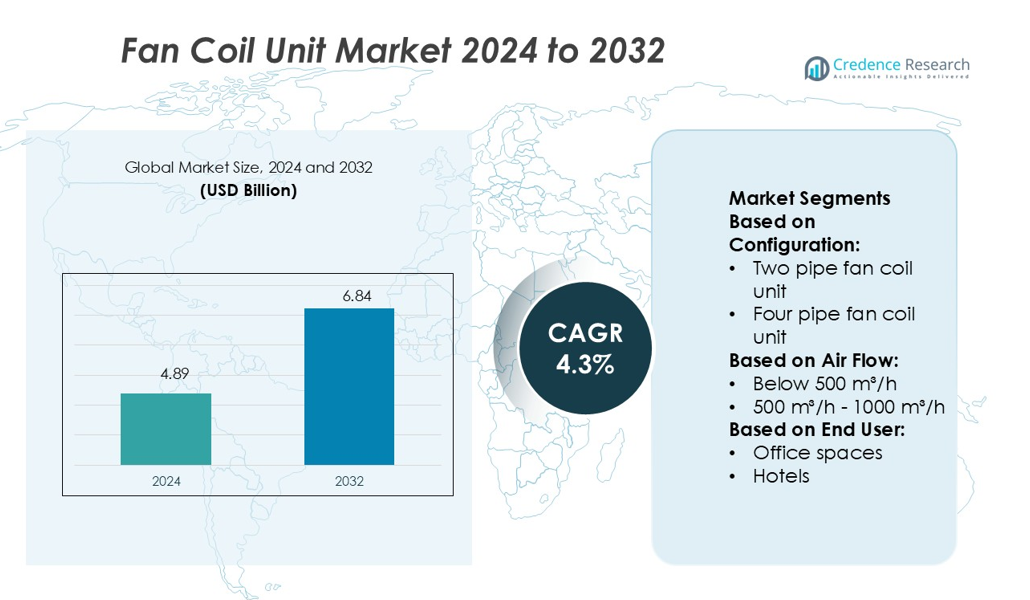1. Introduction
1.1. Report Description
1.2. Purpose of the Report
1.3. USP & Key Offerings
1.4. Key Benefits for Stakeholders
1.5. Target Audience
1.6. Report Scope
1.7. Regional Scope
2. Scope and Methodology
2.1. Objectives of the Study
2.2. Stakeholders
2.3. Data Sources
2.3.1. Primary Sources
2.3.2. Secondary Sources
2.4. Market Estimation
2.4.1. Bottom-Up Approach
2.4.2. Top-Down Approach
2.5. Forecasting Methodology
3. Executive Summary
4. Introduction
4.1. Overview
4.2. Key Industry Trends
5. Global Fan Coil Unit Market
5.1. Market Overview
5.2. Market Performance
5.3. Impact of COVID-19
5.4. Market Forecast
6. Market Breakup by Configuration
6.1. Two Pipe Fan Coil Unit
6.1.1. Market Trends
6.1.2. Market Forecast
6.1.3. Revenue Share
6.1.4. Revenue Growth Opportunity
6.2. Four Pipe Fan Coil Unit
6.2.1. Market Trends
6.2.2. Market Forecast
6.2.3. Revenue Share
6.2.4. Revenue Growth Opportunity
7. Market Breakup by Air Flow
7.1. Below 500 m³/h
7.1.1. Market Trends
7.1.2. Market Forecast
7.1.3. Revenue Share
7.1.4. Revenue Growth Opportunity
7.2. 500 m³/h – 1000 m³/h
7.2.1. Market Trends
7.2.2. Market Forecast
7.2.3. Revenue Share
7.2.4. Revenue Growth Opportunity
8. Market Breakup by End User
8.1. Office Spaces
8.1.1. Market Trends
8.1.2. Market Forecast
8.1.3. Revenue Share
8.1.4. Revenue Growth Opportunity
8.2. Hotels
8.2.1. Market Trends
8.2.2. Market Forecast
8.2.3. Revenue Share
8.2.4. Revenue Growth Opportunity
9. Market Breakup by Region
9.1. North America
9.1.1. United States
9.1.1.1. Market Trends
9.1.1.2. Market Forecast
9.1.2. Canada
9.1.2.1. Market Trends
9.1.2.2. Market Forecast
9.2. Asia-Pacific
9.2.1. China
9.2.2. Japan
9.2.3. India
9.2.4. South Korea
9.2.5. Australia
9.2.6. Indonesia
9.2.7. Others
9.3. Europe
9.3.1. Germany
9.3.2. France
9.3.3. United Kingdom
9.3.4. Italy
9.3.5. Spain
9.3.6. Russia
9.3.7. Others
9.4. Latin America
9.4.1. Brazil
9.4.2. Mexico
9.4.3. Others
9.5. Middle East and Africa
9.5.1. Market Trends
9.5.2. Market Breakup by Country
9.5.3. Market Forecast
10. SWOT Analysis
10.1. Overview
10.2. Strengths
10.3. Weaknesses
10.4. Opportunities
10.5. Threats
11. Value Chain Analysis
12. Porter’s Five Forces Analysis
12.1. Overview
12.2. Bargaining Power of Buyers
12.3. Bargaining Power of Suppliers
12.4. Degree of Competition
12.5. Threat of New Entrants
12.6. Threat of Substitutes
13. Price Analysis
14. Competitive Landscape
14.1. Market Structure
14.2. Key Players
14.3. Profiles of Key Players
14.3.1. Honeywell International
14.3.1.1. Company Overview
14.3.1.2. Product Portfolio
14.3.1.3. Financials
14.3.1.4. SWOT Analysis
14.3.2. Gree Electric Appliances
14.3.2.1. Company Overview
14.3.2.2. Product Portfolio
14.3.2.3. Financials
14.3.2.4. SWOT Analysis
14.3.3. Carrier Global Corporation
14.3.3.1. Company Overview
14.3.3.2. Product Portfolio
14.3.3.3. Financials
14.3.3.4. SWOT Analysis
14.3.4. Daikin Industries
14.3.4.1. Company Overview
14.3.4.2. Product Portfolio
14.3.4.3. Financials
14.3.4.4. SWOT Analysis
14.3.5. Dunham-Bush
14.3.5.1. Company Overview
14.3.5.2. Product Portfolio
14.3.5.3. Financials
14.3.5.4. SWOT Analysis
14.3.6. Lennox International
14.3.6.1. Company Overview
14.3.6.2. Product Portfolio
14.3.6.3. Financials
14.3.6.4. SWOT Analysis
14.3.7. Johnson Controls International
14.3.7.1. Company Overview
14.3.7.2. Product Portfolio
14.3.7.3. Financials
14.3.7.4. SWOT Analysis
14.3.8. Fujitsu General Limited
14.3.8.1. Company Overview
14.3.8.2. Product Portfolio
14.3.8.3. Financials
14.3.8.4. SWOT Analysis
14.3.9. Aermec
14.3.9.1. Company Overview
14.3.9.2. Product Portfolio
14.3.9.3. Financials
14.3.9.4. SWOT Analysis
14.3.10. Emerson Electric
14.3.10.1. Company Overview
14.3.10.2. Product Portfolio
14.3.10.3. Financials
14.3.10.4. SWOT Analysis
15. Research Methodology








